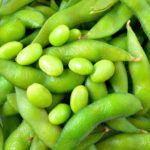Soybean
Soybean

TM: Europe, Asia (China), Pharm., Comm.E+, PhEur8. DS: lecithin.
Soy lecithin is used for appetite loss, chronic hepatitis, inflammatory bowel disease and acne. It is linked to the low incidence of cancer in East Asian people.
Soybean origins are rooted in Asia, where it was an old Chinese cultigen. Soybean is an erect annual herb; leaves trifoliate; flowers minute, pink; fruit a few-seeded pod. Allergy to soy is quite common.
Soy lecithin is used for appetite loss, chronic hepatitis, inflammatory bowel disease and acne. It is linked to the low incidence of cancer in East Asian people.
Soybean origins are rooted in Asia, where it was an old Chinese cultigen. Soybean is an erect annual herb; leaves trifoliate; flowers minute, pink; fruit a few-seeded pod. Allergy to soy is quite common.
In recent years, some of their beneficial effect on human health have come to light. Phytosterols can lower intestinal cholesterol absorption, thereby reducing serum levels of low-density lipoproteins and the risk of atherosclerosis. The pharmaceutical industry has a long history of converting phytosterols to a therapeutic steroid hormones by microbial transformation.
One commercially available phytosterol product is a phytosterol mixture extracted from soybean oil deodorizer distillate. Soybean phytosterols usually include four sterols: β-sitosterol, stigmasterol, campesterol, and brassicasterol, all of which make good raw materials for the production of steroid hormones because of their typical Aring molecular structure with 3β-hydroxyl group and a 5,6-double bond.
In recent years, some of their beneficial effect on human health have come to light. Phytosterols can lower intestinal cholesterol absorption, thereby reducing serum levels of low-density lipoproteins and the risk of atherosclerosis. The pharmaceutical industry has a long history of converting phytosterols to a therapeutic steroid hormones by microbial transformation.
One commercially available phytosterol product is a phytosterol mixture extracted from soybean oil deodorizer distillate. Soybean phytosterols usually include four sterols: β-sitosterol, stigmasterol, campesterol, and brassicasterol, all of which make good raw materials for the production of steroid hormones because of their typical Aring molecular structure with 3β-hydroxyl group and a 5,6-double bond.
Two kinds of steroid hormone intermediates can be produced from soybean phytosterols through microbial transformation. The first of these are the C19-steroids, which include androsta-4-ene-3,17-dione (AD), androsta-1,4-dien-4,17-dione (ADD), 9β-hydroxyandrostra-4-ene-3,17-dione, and testosterone; the second are the C22-steroids, such as 20-carboxy-pregna-I,4-dien-3-one and 20-hydroxymethylpregna-1.4-dien-3-one.
C19-steroids are the products of complete side chain cleavage. They can be used as precursors to almost all kinds of steroid hormones, including sex hormones, anabolic steroids, and even adrenocortical hormones. C22-steroids are the products of truncated side chain. These make good precursors to adrenocortical hormones. The chemical conversion of sapogenins to steroids is a well-established alternative to microbial transformation of phytosterols to steroids.
Two kinds of steroid hormone intermediates can be produced from soybean phytosterols through microbial transformation. The first of these are the C19-steroids, which include androsta-4-ene-3,17-dione (AD), androsta-1,4-dien-4,17-dione (ADD), 9β-hydroxyandrostra-4-ene-3,17-dione, and testosterone; the second are the C22-steroids, such as 20-carboxy-pregna-I,4-dien-3-one and 20-hydroxymethylpregna-1.4-dien-3-one.
C19-steroids are the products of complete side chain cleavage. They can be used as precursors to almost all kinds of steroid hormones, including sex hormones, anabolic steroids, and even adrenocortical hormones. C22-steroids are the products of truncated side chain. These make good precursors to adrenocortical hormones. The chemical conversion of sapogenins to steroids is a well-established alternative to microbial transformation of phytosterols to steroids.